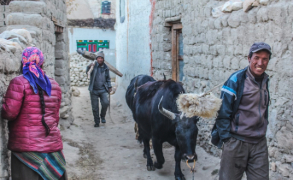Asking the right questions in adaptation research and practice: Seeing beyond climate impacts in rural Nepal

Highlights
- Conventional adaptation narrows the problem context, ignoring political economy.
- Technological adaptation strategies are out of step with how households adapt.
- In particular, adaptation in agriculture needs to move beyond impacts on production.
- We understand this as an epistemological problem; adaptation needs a wider framing.
- This means asking: what changes are people facing? How do these link to climate?
Introduction
Adaptation research and practice too often overlooks the wider social context within which climate change is experienced. Mainstream approaches frame adaptation problems in terms of the consequences that flow from biophysical impacts and as a result, the authors argue, ask the wrong questions.
This paper illustrates how this kind of approach frames a different set of questions about adaptation using the case of Nepal. Drawing on fieldwork and a review of literature, a contrast is made between the questions that emerge from adaptation research and practice that take climate risk as a starting point with the questions that emerge from examination of contemporary rural livelihoods.
This paper was published in Environmental Science & Policy in April 2019.
The text below is a summary of this research report. Please download the full document from the right-hand column for much more information.
Findings
The authors find that while adaptation efforts are often centred around securing agricultural production and are predicated on climate risk management, rural livelihoods are caught in a wider process of transformation. The numbers of people involved in farming are declining, and households are experiencing the effects of rising education, abandonment of rural land, increasing wages, burgeoning mechanisation, and high levels of migration into the global labour market. They find the epistemological framing of adaptation too narrow to account for these changes, as it understands the experiences of rural communities through the lens of climate risk.
- Transitions and transformations in rural livelihoods:
South Asian rural livelihoods have gone through fundamental social-political transitions during the past several decades. After the radical change that the ‘Green revolution’ brought to farming systems, rural livelihoods have taken a turn towards decreased dependency on agriculture and the growing importance of non-farm income (Mallik, 2014).
- Male out-migration:
A central phenomenon across the research sites was a widespread lack of adequate labour available for agricultural work. The outmigration of young rural Nepalis, driven by work and education opportunities offered in urban centres and abroad (Korzenevica and Agergaard, 2017), has major implications for household farming systems. Participants in this research reported that the cooperative labour that used to be common about two decades ago has simply ceased to exist.
- Extreme weather events:
Respondents in Kaski and Chitwan districts rarely referred to weather or climate as significant issues affecting livelihoods, and, although many aspects of social and livelihood change were discussed, no respondents attributed these to climate change. Only when specifically asked about changes in climate, did respondents describe variations and unusual weather and statements such as “this year the rain did not come in time” were common.
- On- and off-farm livelihood changes:
Despite these discussions of climatic change and extreme events, our interviews revealed changes in farming practices were interconnected with three main factors: migration, labour availability and markets.
Households with fewer people to manage lands are shifting towards either renting land for commercial vegetable production, or incorporating perennial and other less labour demanding crops.
Crop-specific labour arrangements vary in different stages of production, and our observations of agricultural activities indicate that mechanisation seems to be occurring only at discrete points in the process.
Conclusion
The article proposes that rather than seeking to integrate local understandings into a fixed, impacts-orientated epistemology, it is necessary to premise adaptation on an epistemology capable of exploring how change occurs. Asking the right questions thus means opening up adaptation by asking: ‘what are the most significant changes taking place in people’s lives?’, along with the more standard: ‘what are the impacts of climate change?’
Viewing adaptation as occurring between and within these two perspectives has the potential to reveal new vulnerabilities and opportunities for adaptation practice to act upon.

Comments
There is no contentYou must be logged in to reply.